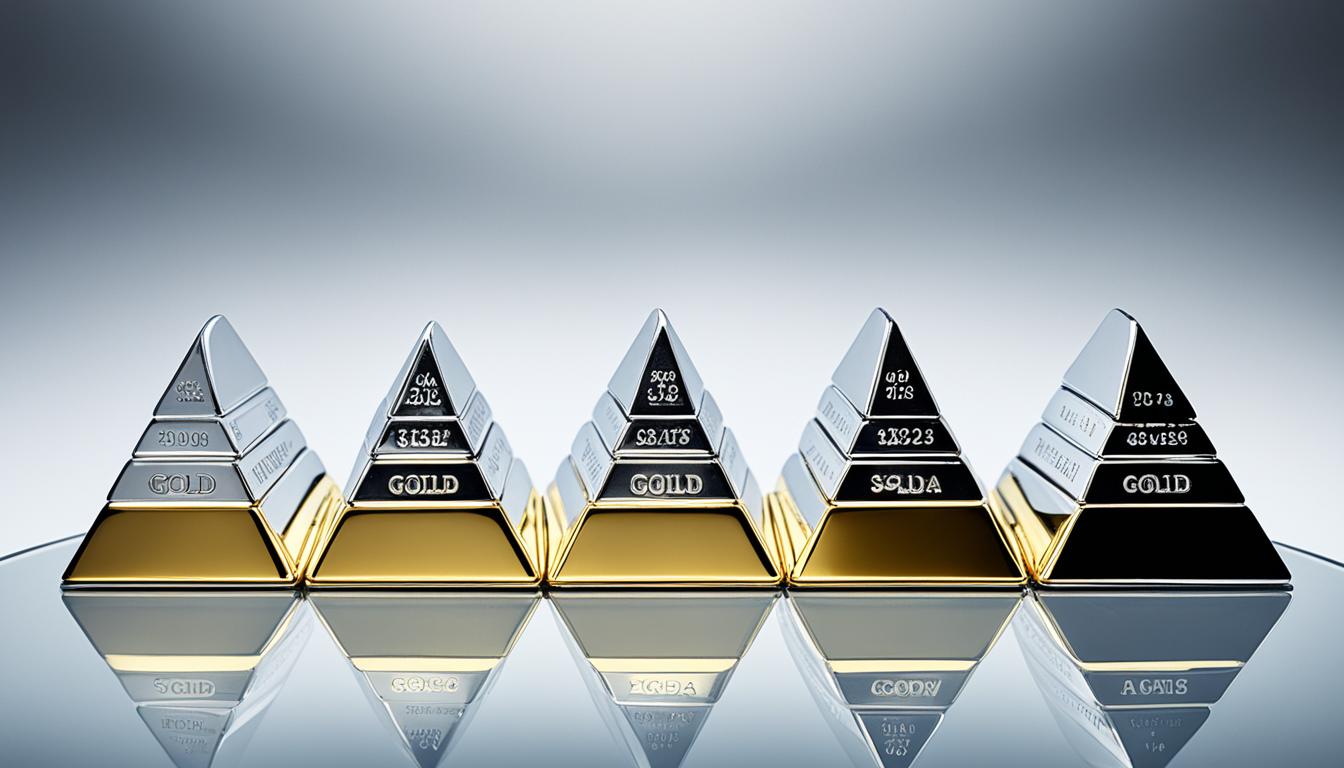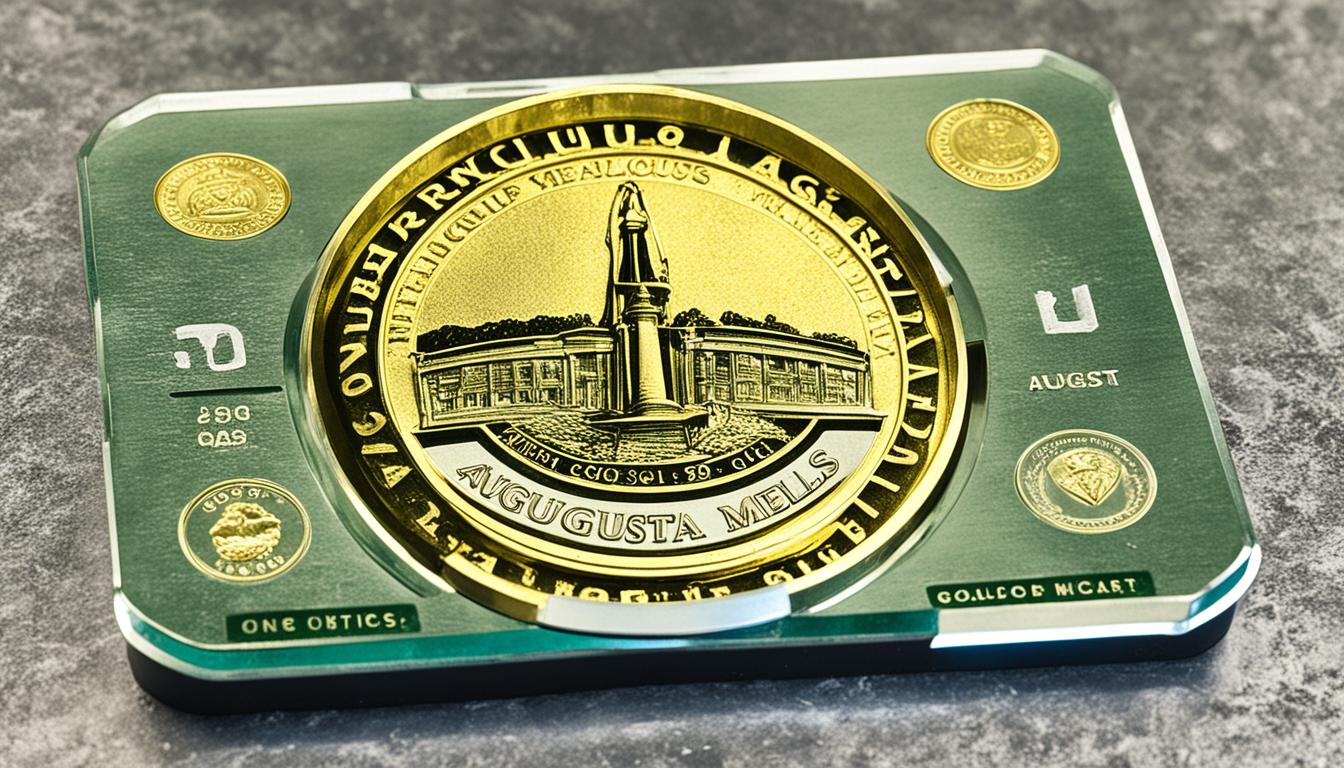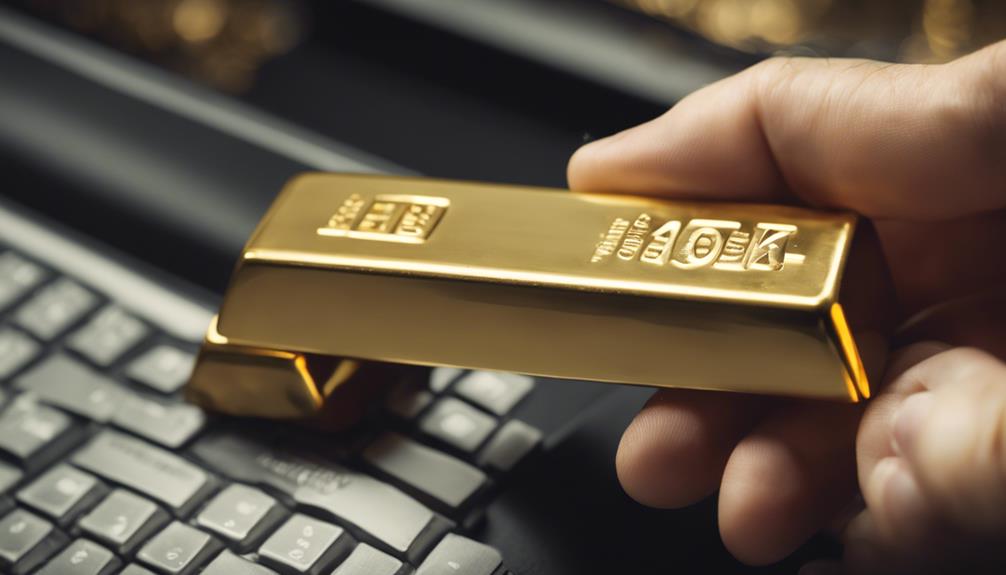During the global financial crisis in 2008, were you aware that the price of gold surged by an impressive 27%? This significant increase emphasized the significance of having a balanced investment portfolio that incorporates precious metals. Investing in gold and silver can offer protection against stock market fluctuations and assist in preserving your wealth. If you are unsure about how much to invest in precious metals and which allocation strategy to pursue, this guide will provide you with the necessary information.
Key Takeaways:
- Diversifying your portfolio with precious metals can help reduce exposure to stock market volatility and serve as a long-term store of value.
- Gold and silver are considered alternative assets that can protect your wealth during economic declines or crises.
- It is generally recommended to allocate 5% to 15% of your portfolio to gold and silver, depending on your risk sensitivity.
- There are different ways to buy precious metals, including physical gold bullion and gold ETFs, each offering unique advantages.
- Consider your financial goals, risk tolerance, and the economic context when deciding how much gold and silver to hold in your portfolio.
Why Gold And Silver Are Worth Adding To Your Portfolio
In today’s volatile economic landscape, investors are increasingly turning to alternative assets for portfolio diversification and as a store of value. Gold and silver have long been recognized as valuable assets that provide stability and protection against market volatility.
Keynesian monetary policy and the natural boom-and-bust cycle of the economy make gold and silver particularly valuable. These precious metals have a track record of preserving wealth during times of economic decline or crisis, acting as a hedge against traditional asset volatility.
“Gold and silver have stood the test of time as a reliable store of value, maintaining their worth even when other investments falter.” Gold IRA Markets
For entrepreneurs and individuals navigating the uncertainties of the startup world, investing in gold and silver can provide a much-needed sense of stability. These precious metals can help safeguard wealth and mitigate risk, providing a layer of protection against the inherent volatility of entrepreneurial endeavors.
Historically, gold and silver have held their value during times of inflation, currency devaluation, and market downturns. This stability makes them attractive as a long-term investment, allowing investors to diversify their portfolios and reduce dependence on traditional stocks and bonds.
Adding gold and silver to your portfolio not only provides diversification but also offers a tangible asset that you can rely on in times of economic uncertainty. Unlike paper assets that can lose value overnight, physical gold and silver are inherently valuable and can be held as a safeguard against market turbulence.
By investing in gold and silver, investors can take advantage of the unique properties of these precious metals. Gold and silver act as a counterbalance to traditional investments, providing stability and protection in uncertain times.
Next, we will explore the optimal asset allocation for gold and silver, helping you determine the right balance for your portfolio.

What Asset Allocation Should You Reserve For Gold And Silver?
The share of your portfolio dedicated to precious metals depends on your risk sensitivity. To achieve portfolio diversification, financial advisors typically recommend allocating a portion, usually between 5% to 15%, of your investment to gold and silver. This allocation serves as a hedge against stock market volatility and provides potential protection during economic downturns.
When deciding on the appropriate allocation, it is vital to strike a balance that optimizes risk management and potential returns. Allocating too high a percentage to gold and silver may limit your exposure to other asset classes, potentially causing you to miss out on higher returns from those investments. On the other hand, allocating too little may leave your portfolio vulnerable to risks that can be mitigated by having exposure to precious metals.
“The key is to find the right asset allocation that fits your risk tolerance and investment objectives.” IRA Rollover to Gold
Gold and silver have historically shown low correlation with the performance of stocks and bonds, making them an attractive option for diversification. By including these alternative assets in your portfolio, you can potentially reduce overall volatility and enhance its stability.
It’s important to note that the ideal asset allocation for gold and silver may vary depending on your individual circumstances and investment goals. Factors such as age, investment horizon, and economic outlook should all be taken into consideration.
Understanding Risk Sensitivity
Your risk sensitivity plays a significant role in determining the percentage of your portfolio that should be allocated to gold and silver. A risk-averse investor may lean towards a higher allocation to these precious metals as a means of wealth preservation and to mitigate downside risks. Conversely, a risk-seeking investor may choose a relatively lower allocation, prioritizing potential growth opportunities in other asset classes.
Considering Long-Term Objectives
When allocating your portfolio, it’s crucial to align your investment decisions with your long-term objectives. If you’re looking for stability and wealth preservation over time, a higher allocation to gold and silver may be appropriate. On the other hand, if you’re seeking higher potential returns and liquidity, a larger allocation to other asset classes may be preferred.
Ultimately, the asset allocation decision is unique to each individual and should be based on a comprehensive analysis of your risk appetite, financial goals, and market conditions. Consult with a qualified financial advisor who can help you determine the optimal allocation strategy that aligns with your objectives.
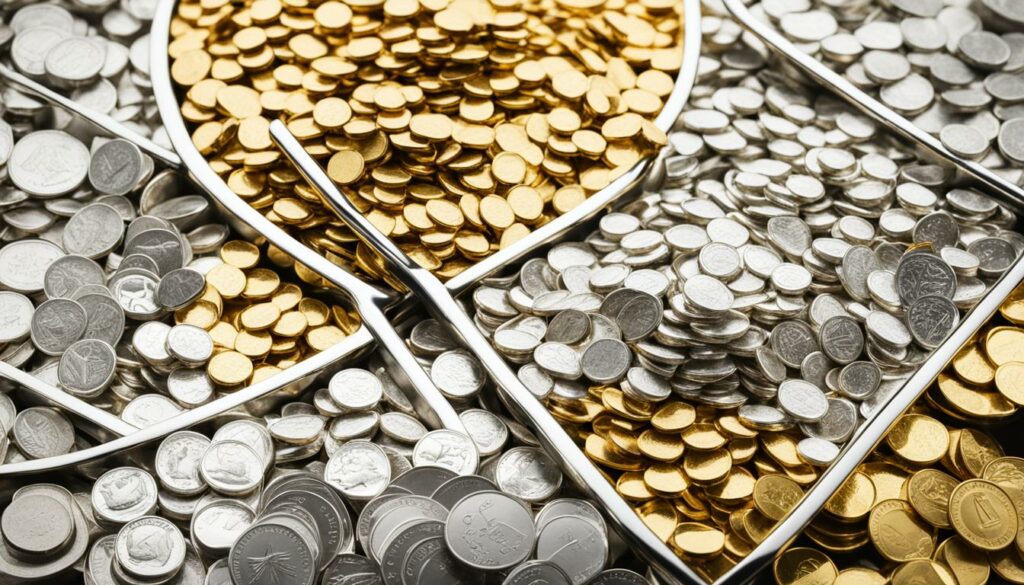
How To Buy Precious Metals
When it comes to buying precious metals, such as gold and silver, there are different options available based on the type of asset you’re interested in. Understanding these options can help you make informed decisions and build a diversified portfolio.
1. Physical Gold Bullion
If you prefer direct ownership of the precious metal, purchasing physical gold bullion is a popular choice. Gold bullion is available in various forms, including bars and coins, and can be bought in large or small amounts. This allows investors to tailor their purchases to their specific budget and investment goals. Many well-established mints and refineries produce high-quality gold bullion products, ensuring that investors receive authentic and trusted assets.
2. Gold ETFs
For investors looking for improved liquidity and convenience in buying and selling gold, gold Exchange-Traded Funds (ETFs) offer a viable alternative. Gold ETFs are investment funds backed by physical gold. These funds allow you to gain exposure to the price of gold without the need for storing or safeguarding physical bullion. They can be purchased and traded on stock exchanges, making them easily accessible for individual investors.
Gold ETFs provide the added advantage of fractional ownership, allowing investors to buy small dollar amounts. This enables them to enter the market with lower initial investments and gradually increase their exposure to gold over time. Additionally, the liquidity of gold ETFs allows investors to easily convert their holdings into cash when needed.
It’s worth noting that gold ETFs are subject to management fees and other expenses that may affect overall returns. Investors should carefully consider these factors before making an investment decision.
Regardless of the method you choose, it’s essential to conduct thorough research and consider factors such as transaction costs, storage options, and the reputation of the seller or issuer. Consulting with a reputable financial advisor can also provide valuable guidance in navigating the buying process and selecting the most suitable option for your investment strategy.
| Buying Method | Advantages | Considerations |
|---|---|---|
| Physical Gold Bullion | – Direct ownership – Tangible asset – Potential for privacy |
– Storage and security – Higher transaction costs – Reduced liquidity for smaller investments |
| Gold ETFs | – Improved liquidity – Fractional ownership – Convenience of trading on stock exchanges |
– Management fees – Lack of physical ownership – Market volatility affecting price |
No matter which method you choose, buying precious metals can be a valuable addition to your investment portfolio. The decision between physical gold bullion and gold ETFs depends on your individual preferences, financial goals, and risk tolerance. By diversifying your portfolio with these alternative assets, you can potentially safeguard your wealth and mitigate the risks associated with traditional investments.
Benefits Of Bullion Vs. ETFs
Investors interested in adding gold to their portfolio have two main options: gold bullion and gold ETFs. Each option comes with its own set of benefits and considerations. Let’s explore the advantages of both:
The Benefits of Gold Bullion
Gold bullion offers direct ownership and the ability to physically own the precious metal. This provides investors with a tangible asset that can be transferred easily. Holding physical gold bullion can provide a sense of security and ownership that some investors prefer. Additionally, gold bullion is known for its long-standing history as a store of value, making it a popular choice for those seeking stability in uncertain economic times.
The Benefits of Gold ETFs
On the other hand, gold ETFs, or exchange-traded funds, offer a different set of advantages. ETFs provide improved liquidity and can be easily bought and sold on the stock market. This makes them a convenient option for investors looking for flexibility and easy access to gold investments. Additionally, ETFs trade at the net value of the underlying asset, allowing investors to track the price movements of gold more easily.
Moreover, gold ETFs also offer the benefit of being divisible, allowing investors to purchase them in small dollar amounts. This makes gold ETFs more accessible to a wider range of investors who may not have the means to buy large quantities of physical gold bullion.
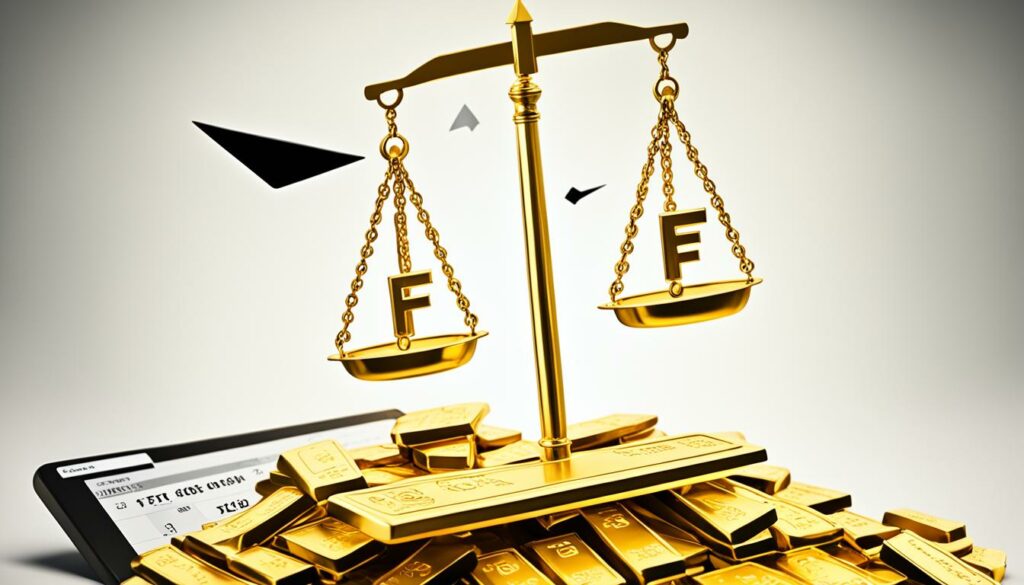
Comparing Gold Bullion and Gold ETFs
Let’s compare the key differences between gold bullion and gold ETFs:
| Gold Bullion | Gold ETFs |
|---|---|
| Direct ownership of physical gold | Improved liquidity |
| Can be transferred easily | Trade at the net value of the asset |
| Taxed as a collectible | Divisible for small dollar investments |
It’s important to note that while gold bullion offers the advantage of direct ownership, it is taxed as a collectible, which is something investors should consider. On the other hand, gold ETFs provide improved liquidity and can be purchased in smaller dollar amounts, making them more accessible to a wider range of investors. However, investors should keep in mind that with gold ETFs, they do not retain full ownership over the underlying gold.
“Gold bullion provides a sense of ownership, while gold ETFs offer liquidity and convenience.” Gold IRA Rollovers
When deciding between gold bullion and gold ETFs, investors should consider their own preferences, financial goals, and risk tolerance. Consulting with a financial advisor can help determine which option aligns best with your investment objectives and overall portfolio strategy.
Gold And Silver: Wise Investments
When it comes to safeguarding wealth and protecting your portfolio from stock market volatility, gold and silver investments can offer valuable benefits. Whether you choose to invest in physical bullion or opt for gold and silver ETFs, these precious metals have proven to be reliable assets during times of economic uncertainty. As the value of the dollar declines and financial vulnerabilities persist in the global economy, considering gold and silver as part of your investment strategy is a wise decision.
Gold and silver have long been regarded as safe-haven assets that can preserve wealth and provide a hedge against market volatility. These precious metals have a track record of maintaining their value, even when other investment options falter. By including gold and silver in your portfolio, you can diversify your holdings and reduce your exposure to the risks associated with traditional assets.
Protecting Your Wealth with Gold and Silver
During times of economic downturn or crisis, gold and silver investments can act as a safeguard for your wealth. These precious metals have historically demonstrated their ability to retain value, making them reliable assets for protecting your portfolio. As stock markets experience volatility and currencies fluctuate, gold and silver can serve as a stable store of value. Their intrinsic worth and limited supply make them resilient in the face of economic uncertainties.
Moreover, the current global economic expansion has been unprecedented, raising concerns about potential market corrections. By allocating a portion of your portfolio to gold and silver, you can mitigate the risks associated with overexposure to traditional asset classes. These precious metals offer a level of security that can help weather financial storms and safeguard your wealth.
Reducing Risk and Increasing Diversification
“Gold and silver investments provide an essential layer of diversification that can protect your portfolio from stock market volatility and economic instability.” The Liberty Portfolio – Expert Investor
Adding gold and silver to your investment strategy allows you to diversify your holdings and reduce the overall risk of your portfolio. Stock market volatility is an inherent characteristic of the market, and traditional assets such as stocks and bonds can be susceptible to significant price fluctuations. By including gold and silver, you introduce assets that have historically shown little correlation with other investment classes, making them effective diversification tools.
Financial advisors often recommend allocating a portion of your portfolio to alternative assets like gold and silver. This allocation strategy helps balance risk and potentially enhance returns by reducing the impact of market downturns on your overall wealth. By diversifying your investments, you spread your risk and create a more resilient portfolio.
Gold and Silver Investments vs. Traditional Assets
| Asset Class | Volatility | Risk/Return Profile | Inflation Hedge |
|---|---|---|---|
| Stocks | High | High Risk/High Return | Partial |
| Bonds | Low to Medium | Low Risk/Low Return | Partial |
| Gold and Silver | Low | Moderate Risk / Moderate Return | Effective |

The table above highlights the key characteristics of gold and silver investments compared to traditional assets such as stocks and bonds. Gold and silver exhibit lower volatility, making them a more stable choice for risk-averse investors. Additionally, these precious metals provide an effective hedge against inflation, preserving your purchasing power in times of rising prices.
By incorporating gold and silver investments into your portfolio, you can balance risk, diversify your holdings, and safeguard your wealth against stock market volatility and economic instability. Whether you choose physical bullion or opt for ETFs, gold and silver offer valuable benefits that can enhance the resilience of your overall investment strategy.
Deciding How Much Gold And Silver to Hold in Your Portfolio
When it comes to allocating gold and silver in your investment portfolio, there is no one-size-fits-all answer. The decision of how much to hold depends on various factors, including personal preferences, risk tolerance, and the economic and geopolitical context. While traditional recommendations suggest allocating about 10-15% of your wealth to precious metals, it’s important to consider your individual circumstances before making a decision.
In understanding the allocation of gold and silver, Exter’s Pyramid is often referenced. Exter’s Pyramid is a visual representation of the relative risk and value of different assets during times of financial crisis. At the base of the pyramid is physical gold, considered the safest asset to hold during turbulent times. As you move up the pyramid, assets become riskier and less valuable.
However, Exter’s Pyramid is just one piece of the puzzle. It’s crucial to consider your own risk tolerance and investment goals. If you have a higher risk tolerance and believe in the long-term store of value that gold and silver provide, you may choose to allocate a larger percentage of your portfolio to these precious metals. On the other hand, if you prefer a more conservative approach, a smaller allocation may be more suitable.
“The key is to strike a balance that aligns with your financial goals and risk tolerance.”
Beyond personal factors, staying informed about the economic and geopolitical landscape is crucial. Gold and silver often perform well during times of economic uncertainty and inflation. By staying up to date with current events and trends, you can make more informed decisions about the allocation of gold and silver in your portfolio.
Considering Gold and Silver as a Hedge
Gold and silver are widely regarded as hedges against inflation and stock market volatility. They have a historical track record of preserving wealth in times of economic crisis. By allocating a portion of your portfolio to gold and silver, you can potentially safeguard your investments in the face of uncertainty.
It’s worth noting that gold and silver prices can be influenced by various factors such as supply and demand dynamics, global economic conditions, and investor sentiment. Therefore, it’s important to carefully consider your investment horizon and how gold and silver fit into your overall portfolio diversification strategy.
Personalized Allocation based on Risk and Goals
Ultimately, the decision of how much gold and silver to hold in your portfolio is a personal one. It depends on your risk tolerance, investment goals, and your outlook on the global economic landscape. While some investors may be comfortable with a smaller allocation, others may choose to hold a larger percentage of their wealth in precious metals.
It’s advisable to consult with a trusted financial advisor who can analyze your specific circumstances and help you determine the optimal allocation strategy. By considering your personal risk profile, investment horizon, and the guidance of professionals, you can make an informed decision about how much gold and silver to hold in your portfolio.
“Remember, the allocation of gold and silver should align with your risk tolerance, investment goals, and the economic climate.”
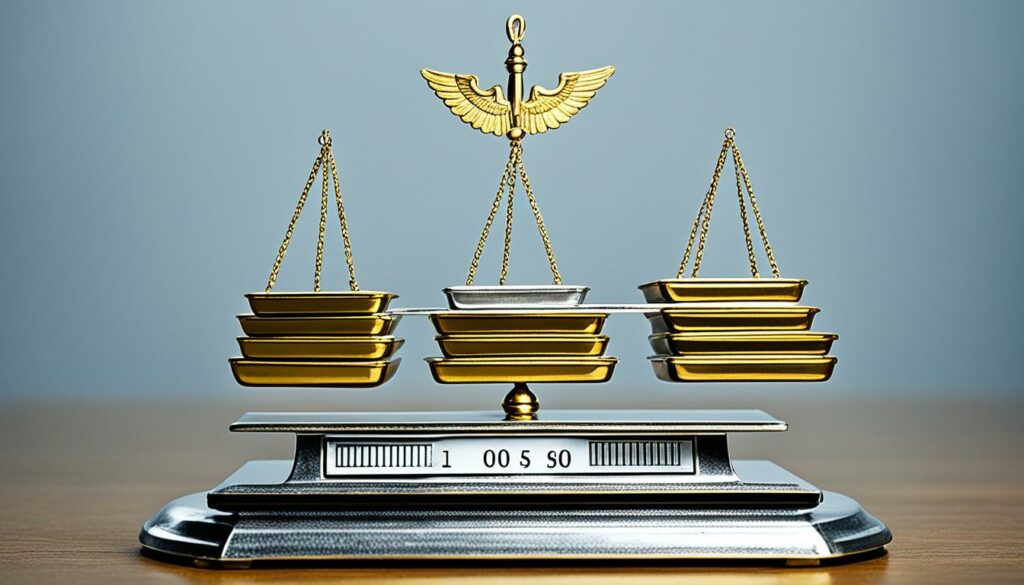
| Investor Profile | Gold Allocation | Silver Allocation |
|---|---|---|
| Conservative Investors | 10-15% | 5-10% |
| Moderate Investors | 15-20% | 10-15% |
| Aggressive Investors | 20-25% | 15-20% |
Table: Gold and Silver Allocation Recommendations
How Your Age and Financial Goals Impact Gold and Silver Allocation
When considering how much gold and silver to hold in your investment portfolio, it’s important to take into account your age and financial goals. These factors can significantly influence the allocation strategy for these precious metals, allowing you to align your investment decisions with your personal circumstances and objectives.
For younger investors who have a longer investment horizon, allocating a higher percentage of their portfolio to silver can be a wise choice. Silver has historically demonstrated a higher rate of return compared to gold, making it an attractive option for those seeking potentially higher investment gains. By incorporating silver into their portfolio, younger investors can capitalize on its growth potential.
On the other hand, older investors who are approaching retirement or have already entered this phase may choose to allocate a larger portion of their wealth into gold. Gold is often considered a safe haven asset and a store of value, particularly during times of financial uncertainty. By increasing their gold allocation, older investors can utilize it as part of their estate planning strategy, protecting their wealth and diversifying their holdings beyond traditional stocks and bonds.
A Case Study: Age-Based Allocation
“As a financial planner, I often recommend age-based allocation strategies to my clients. The idea is to gradually shift the allocation of precious metals based on the client’s age and investment goals. Younger clients with a longer investment horizon can allocate a higher percentage to silver, whereas older clients nearing retirement may favor a higher allocation to gold for wealth preservation and portfolio diversification. This approach allows clients to adjust their allocations dynamically as they move through different stages of their financial lives.”
By tailoring your gold and silver allocation to your age and financial goals, you can effectively manage risk and enhance portfolio diversification. This strategic approach takes into account the specific needs and objectives of different investor demographics, allowing for a more personalized investment strategy.
It’s important to note that there is no one-size-fits-all approach to gold and silver allocation. Individual circumstances, risk tolerance, and investment objectives should be carefully considered when determining the optimal allocation strategy for your portfolio. Consulting with a financial advisor can provide valuable insights and guidance in aligning your allocation with your overall financial plan.
| Investor Profile | Recommended Gold Allocation | Recommended Silver Allocation |
|---|---|---|
| Youthful Investor (age 25-35) | 5% | 15% |
| Mid-Life Investor (age 36-55) | 10% | 10% |
| Nearing Retirement (age 56-65) | 15% | 5% |
Table: Recommended Gold and Silver Allocations Based on Investor Profile
As illustrated in the table above, age-based allocation strategies recommend different allocations for gold and silver based on the investor’s profile. These recommendations provide a guideline for balancing risk and diversification, emphasizing the importance of portfolio customization to individual circumstances.
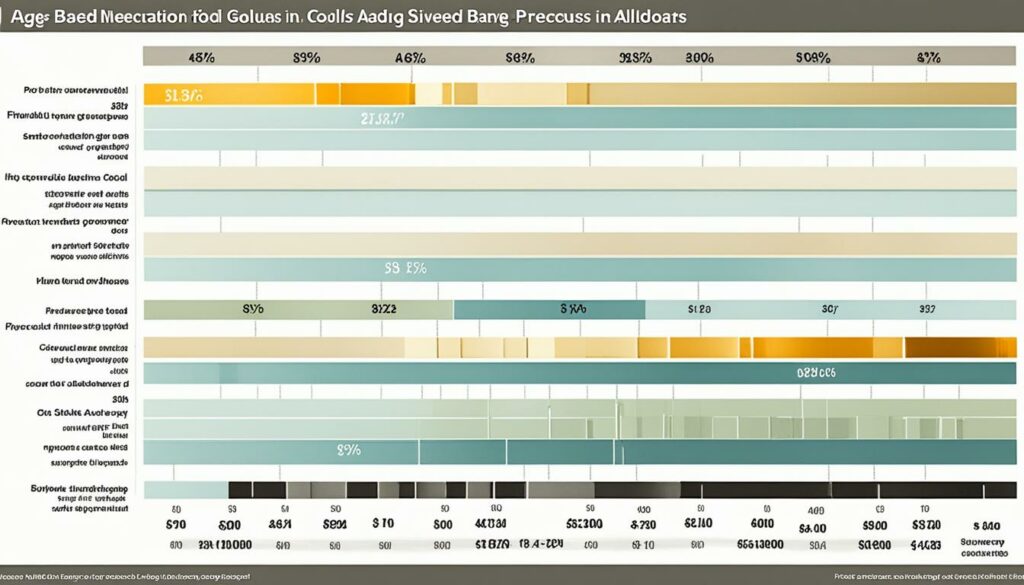
Considerations for Gold vs. Silver Allocation
When deciding on your gold and silver allocation, it’s crucial to consider your overall financial goals. The allocation you choose should align with your objectives and risk tolerance. Here are some key considerations to keep in mind:
1. Stability and Hedge Against Economic Shocks
If stability and a hedge against economic shocks are your main goals, it may be wise to weight your allocation more heavily towards gold. Gold is often seen as a safe haven during times of economic uncertainty and market volatility. Its value tends to remain relatively stable, making it an effective hedge against inflation and currency fluctuations.
2. Higher Potential Return and Liquidity
If you’re looking for an asset with higher potential return and greater liquidity, you may want to allocate a larger percentage to silver. Silver has historically shown more volatility than gold, which can lead to higher returns for investors. Additionally, silver is widely used in various industries, which can contribute to its liquidity and demand.
However, it’s important to note that silver’s volatility can also pose greater risks. It may experience larger price fluctuations compared to gold, requiring investors to closely monitor their holdings and adjust their allocation accordingly.
“Consider your overall financial goals and the specific characteristics of gold and silver when determining your allocation.”
3. Diversification and Risk Management
Both gold and silver have a role to play in diversifying your investment portfolio. Precious metals, as alternative assets, can provide a level of diversification that helps mitigate risks associated with traditional asset classes like stocks and bonds. By including gold and silver in your allocation, you can reduce the overall volatility and potential losses of your portfolio.
It’s worth mentioning that the optimal gold and silver allocation depends on your specific goals and individual circumstances. Factors such as your risk tolerance, investment horizon, and the economic and geopolitical context should be taken into account when determining the right balance between the two metals.
To illustrate the different considerations for gold and silver allocation, here is a comparative table:
| Consideration | Gold | Silver |
|---|---|---|
| Stability | High | Lower than gold |
| Potential Return | Lower than silver | Higher |
| Liquidity | High | Lower than gold |
| Diversification | Yes | Yes |
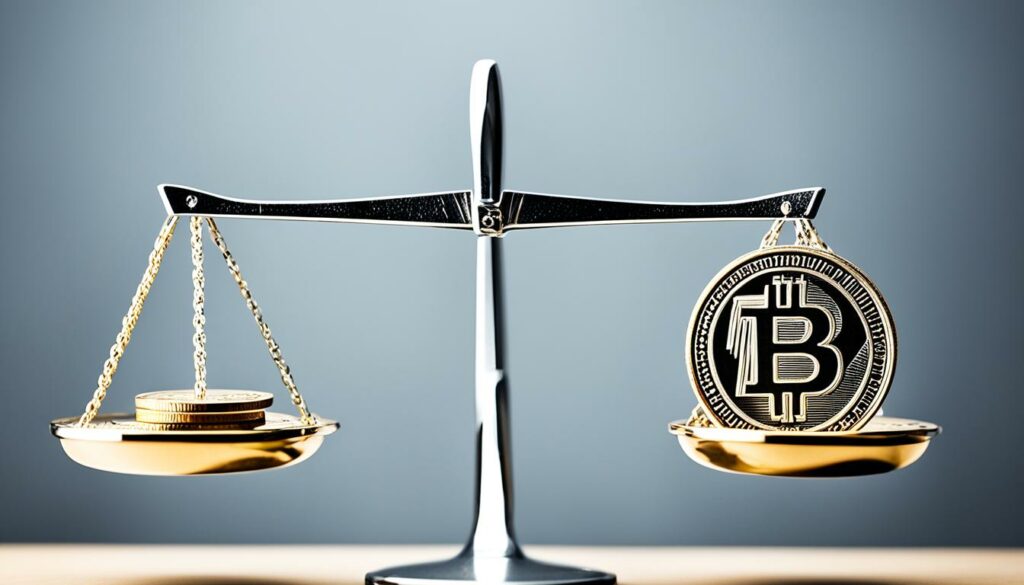
Remember, there is no one-size-fits-all approach to gold and silver allocation. It’s important to carefully evaluate your financial goals, conduct thorough research, and seek advice from a financial advisor before making any investment decisions.
Balancing Risk and Diversification with Gold and Silver
When it comes to managing risk and diversifying your investment portfolio, allocating a portion to precious metals such as gold and silver can be a strategic move. Holding approximately 15% of your wealth in gold and silver is a recommended starting point to achieve portfolio diversification and risk management.
By including gold and silver in your portfolio, you can potentially mitigate the impact of market fluctuations and economic uncertainties. Gold and silver historically have acted as a hedge against inflation and currency devaluation, making them valuable assets during times of economic downturns and volatility.
However, it is important to note that while gold and silver allocation can provide stability and diversification, it is not advisable to allocate 100% of your savings or portfolio to these precious metals. Achieving diversification across different asset classes is key to managing risk effectively.
When fine-tuning your gold and silver allocation, consider your financial goals and preferences. Your investment horizon, risk tolerance, and market outlook are essential factors to consider. Consulting with a financial advisor can help you determine the optimal allocation strategy that aligns with your individual circumstances.
Remember, there is no one-size-fits-all approach to gold and silver allocation. It ultimately depends on your personal financial goals, risk profile, and market outlook. Striking the right balance between risk management, portfolio diversification, and gold and silver allocation is crucial for a well-rounded investment strategy.
So, diversify your portfolio, manage risk, and consider including gold and silver as part of your investment mix.
| Benefits of Gold and Silver Allocation | Risk Management | Portfolio Diversification |
|---|---|---|
| 1. Acts as a hedge against market volatility and economic uncertainties. | 1. Helps mitigate the impact of market fluctuations and currency devaluation. | 1. Reduces exposure to the risks associated with traditional asset classes. |
| 2. Provides a store of value during times of inflation and currency devaluation. | 2. Serves as a long-term store of value and protects against potential financial crises. | 2. Enhances portfolio stability by adding a non-correlated asset class. |
| 3. Potentially increases overall portfolio returns over the long term. | 3. Offers a way to diversify investment risks and potentially reduce volatility. | 3. Can act as a buffer against stock market downturns and economic uncertainties. |
Remember, gold and silver allocation should be based on thorough research, careful analysis, and consultation with a financial advisor. It is just one of the many components in building a well-diversified portfolio that aligns with your financial goals and risk tolerance.

The Role of Trust in Precious Metals
Trust in the banking system has eroded in recent years due to various scandals and the occurrence of bank failures. This loss of confidence has left many individuals searching for alternative methods of preserving their wealth and safeguarding their financial future.
Precious metals, such as gold and silver, have emerged as a trusted method of saving and have a long-standing history as a reliable store of value. Unlike traditional currency, their worth is not dependent on the stability of any particular banking institution or government. Instead, the value of precious metals remains resilient, even during times of economic uncertainty.
One of the key advantages of investing in precious metals is their role as a hedge against financial crises. Throughout history, gold and silver have proven to be valuable assets during times of economic turmoil. They have consistently retained their worth and served as a form of wealth preservation when traditional assets, such as stocks and bonds, have experienced significant volatility.
Banks, on the other hand, have faced numerous challenges in terms of reliability and safety. High-profile scandals involving unethical practices and the mismanagement of funds have shaken public trust in the banking system. In some cases, individuals have lost their hard-earned savings due to bank failures and the ensuing financial fallout.
This loss of trust has prompted many individuals to turn to physical gold and silver as a means of protecting their wealth. Precious metals provide a tangible asset that can be held and stored outside of the traditional banking system. This sense of ownership and control offers individuals a sense of security and peace of mind, knowing that their wealth is not subject to the unpredictable nature of the financial industry.
“Investing in precious metals allows individuals to take control of their financial future and reduce their reliance on the banking system. It provides a level of comfort and stability that cannot be easily replicated by traditional banking methods.”
In summary, the role of trust in precious metals cannot be understated. With the erosion of trust in the banking system, individuals are increasingly turning to gold and silver as a method of saving and protecting their wealth. The appeal of precious metals lies in their historical track record as a reliable store of value and their ability to serve as a hedge against financial crises. By investing in physical gold and silver, individuals can regain a sense of control over their financial future and reduce their reliance on the traditional banking system.

Conclusion
Allocating a portion of your portfolio to precious metals, specifically gold and silver, is a prudent strategy for diversification and protection against economic volatility. By investing in these alternative assets, you can reduce your exposure to stock market fluctuations and ensure a long-term store of value.
Financial advisors recommend an allocation ranging from 5% to 15% of your portfolio in precious metals, depending on your risk tolerance and financial goals. However, it is crucial to consider your personal circumstances and consult with a professional advisor to determine the optimal allocation strategy for your specific needs.
When considering allocating in precious metals, it is important to remember that this strategy is not a one-size-fits-all solution. Each individual’s investment goals and risk appetite may differ, and a tailored approach is necessary. By carefully assessing your own circumstances and working with a financial advisor, you can develop an allocation strategy that aligns with your investment objectives and helps secure your financial future.
FAQ
How much should I invest in precious metals?
Why should I consider adding gold and silver to my portfolio?
What is the recommended asset allocation for gold and silver?
How can I buy precious metals?
What are the benefits of gold bullion compared to ETFs?
Why are gold and silver considered wise investments?
How should I decide how much gold and silver to hold in my portfolio?
How does my age and financial goals impact gold and silver allocation?
What considerations should I keep in mind when deciding on gold and silver allocation?
How much of my wealth should I allocate to precious metals?
Why should I consider investing in gold and silver instead of relying on the banking system?
How can investing in precious metals protect against economic volatility?
Helen brings a wealth of experience in investment strategy and a deep passion for helping individuals achieve their retirement goals. With a keen understanding of market dynamics, Helen has been instrumental in shaping the vision and direction of Gold IRA Markets. She specializes in creating innovative solutions that align with our clients’ long-term investment objectives.
